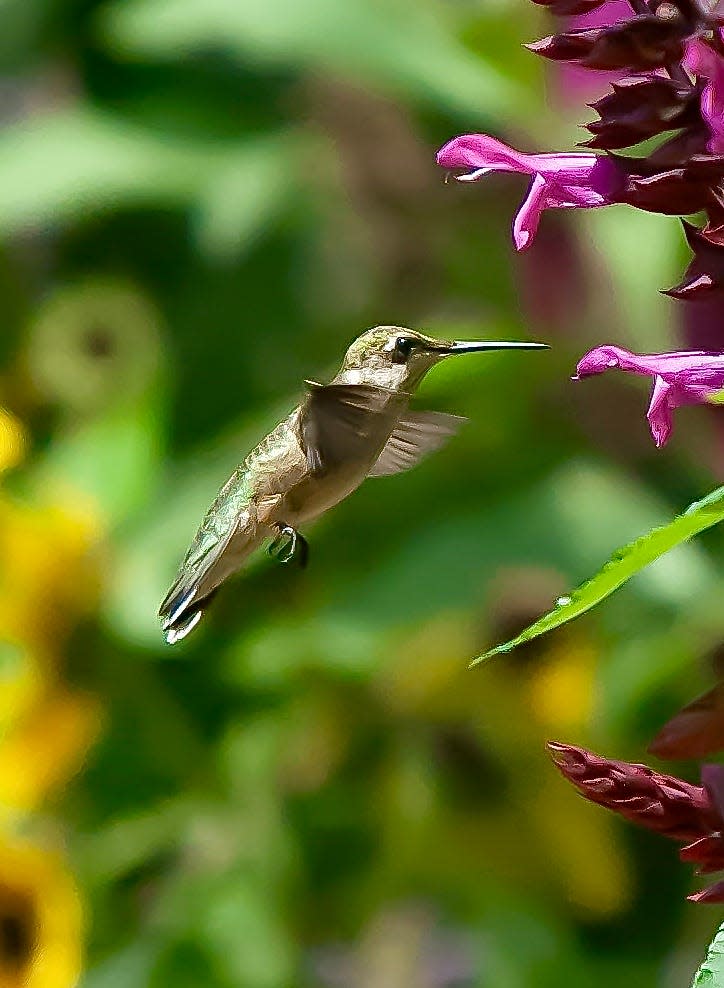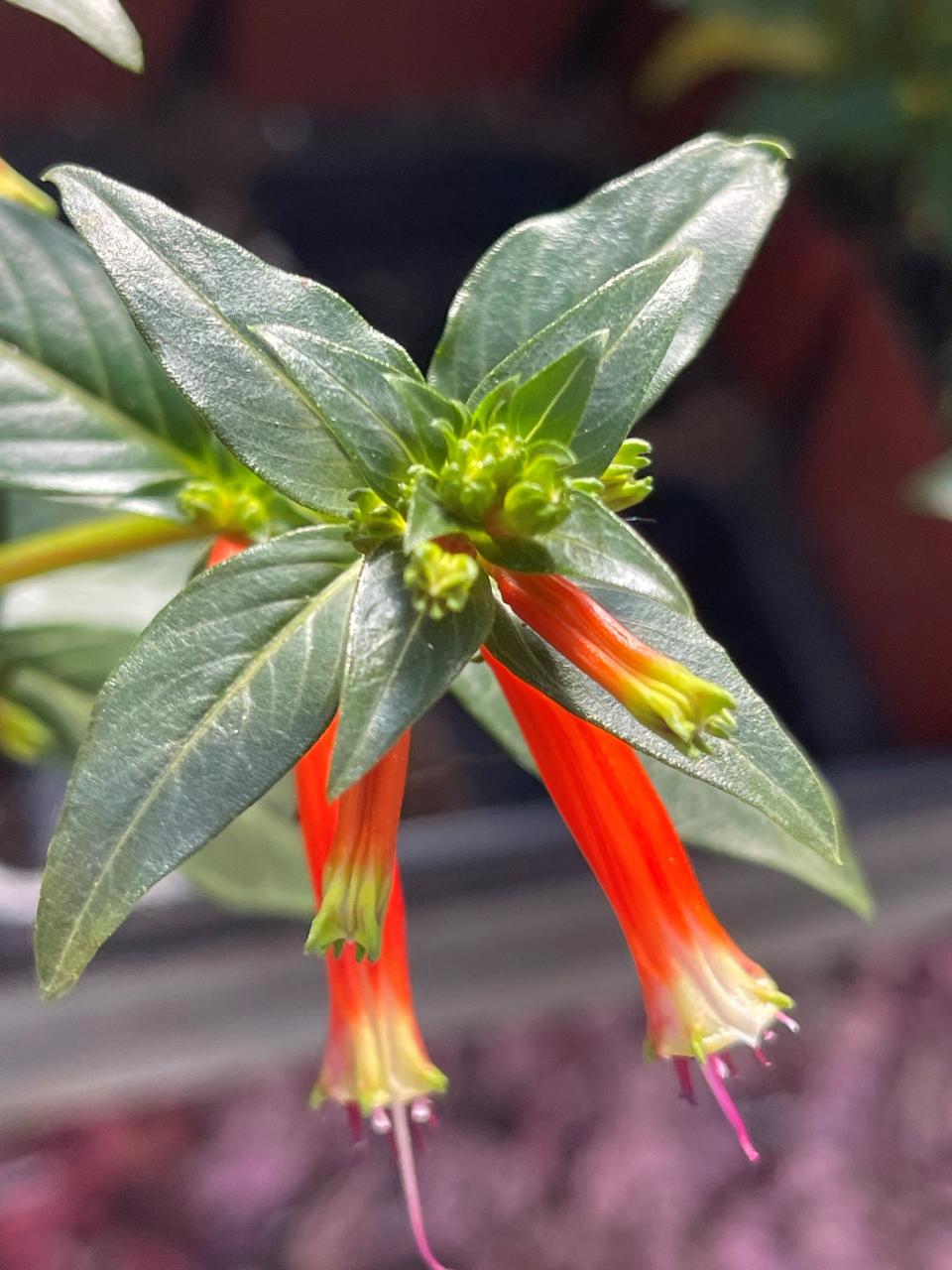Want to welcome hummingbirds to your yard? An easy way to get started is with these totally tubular blooms
Show us a mom who loves flowers, and we’ll show you a mom who also loves hummingbirds.
The two garden beauties — three, if you count Mom — go together, so this Mother’s Day, maybe you want to think outside the box (or pot or hanging basket) and get her a gift that will keep on giving to her tiny winged friends all season: salvia.
It may not have the name recognition of other more traditional “mom flowers,” like petunias, geraniums or roses, but when it comes to attracting hummingbirds, it’s hard to find an annual that’s more of a magnet. Think of salvia’s fluted flowers with sweet nectar as the equivalent of setting up a flashy lemonade stand in the front yard all summer and then hanging a sign on it that reads: “Free. Help Yourself. All You Can Drink.”

Why salvias? They check a lot of boxes
Hummingbirds aren’t year-round Wisconsin residents, so when they migrate in the spring, gardeners get a little giddy and like to roll out the welcome mat with feeders and some of their flowering favorites. Salvias fit the bill, not just because of the tubular blooms in purples, pinks and blues that hummingbirds are drawn to, but they flower nonstop until frost, giving the birds a late-season fuel-up before their return trip in fall.
Salvias are also troopers when it comes to tolerating the heat and humidity, and are seldom bothered by pests or diseases.
There’s a reason Larry’s Bellevue Gardens grows so many different varieties, not the least of which is co-owner Vicki Rabas happens to love them and plants them in her home gardens.
“There is all different sizes, there’s all different flower shapes, there’s different ways that they grow, but they all appeal to the hummingbirds,” she said. “I really do like them all. I use them all.”
Rabas usually gets about 10 hummingbirds that hang out in the yard each season, but she's always striving for more. Having even just one drop by feels like a compliment.
“We’re all crazy about getting the hummingbirds. That’s a bonus," she said. "If you can get one in your yard, chances are, they’ll come back year after year looking for the food source and lay their eggs and hopefully stick around and bring their babies next year.”

From Hot Lips to Rockin' Deep Purple, here's a few to get you started
Salvias are widely available at locally owned greenhouses in the Green Bay area. Here's a few that Larry's has found to be some of its best performers:
Vibes Ignition Fuchsia: vibrant fuchsia flowers; grows 18 to 24 inches tall.
Hot Lips: dainty bicolor red and white flowers; grows 24 to 26 inches tall.
Skyscraper: tall spikes of pink flowers; grows 14 to 28 inches tall.
Black & Blue: true blue flowers on dark green stems; grows 42 to 48 inches tall.
Rockin’ Deep Purple: a Proven Winners selection with dark purple flowers; grows 24 to 36 inches tall.

Tips for growing salvias: Give them plenty of space and sun
Salvias work well in containers that can be placed on a patio, balcony or near a window for prime viewing of all that hovering and zipping from flower to flower, but pay attention to the height and spacing requirements on the labels for each variety. Some grow several feet tall and get quite full and bushy by later in the season, so it may be best to give them their own container or, if mixing with other annuals, make sure it's a large pot.
Rabas likes to grow hers in the ground as landscape plants, staggering the different varieties and heights around a flagpole to create a one-stop hummingbird attraction.
Salvias like sun — the more the better. But even a spot where they get a half-day of morning or afternoon sun will do.
While they are generally low-maintenance and drama-free plants, they benefit from pinching back spent blooms.
“Definitely deadhead,” Rabas said. “Deadheading promotes a bushier plant. It means more blossoms. It means more food source for your hummingbirds.”

Cigar plants are right up at the top of the hummingbird list, too
Keeping with that totally tubular vibe that hummingbirds look for in flowers, cigar plant (Cuphea ignea) is also high on the list of preferred plants.
“It’s actually called hummingbird’s lunch,” said Grant Wery, owner of Wery’s Blossom Creek in Suamico.
It’s most often seen with petite bright orange flowers, but you can also find other varieties, including “Funny Face” with bicolor pink and yellow blooms and, a new one Larry’s is trying this year, “Cubano Cristo” with dark red flowers.
Cigar plant grows to about 10 to 14 inches, thrives in heat and does best in full or part sun.
Wery said hummingbirds are partial to red or darker colored flowers with a throat. He also recommends red calibrachoa, also sometimes called million bells, an annual with small petunia-like flowers that come in a rainbow of colors for spilling over in hanging baskets and mixed containers.
For the native plant gardener, columbine and bee balm are a must
For moms on the wild side — or just gardeners who are into native plants for pollinators — Justin Kroening, owner of Stone Silo Prairie Gardens in Ledgeview, recommends these native perennials for drawing in hummingbirds: penstemon, tall larkspur, cardinal flower, bee balm and columbine.
Native columbine (Aquilegia canadensis) especially is a favorite, and hummingbirds tend to follow it from south to north as it blooms when they migrate, Kroening said.
“Once you see columbine blooming in the garden you can pretty much be sure the hummingbirds are near,” he said.
Kendra Meinert is an entertainment and feature writer at the Green Bay Press-Gazette. Contact her at 920-431-8347 or [email protected]. Follow her on X @KendraMeinert.
This article originally appeared on Green Bay Press-Gazette: Attracting hummingbirds to your Wisconsin garden starts with salvia
